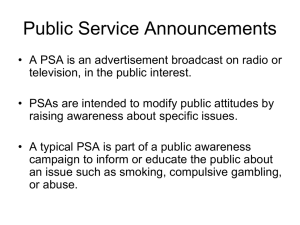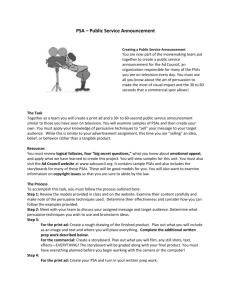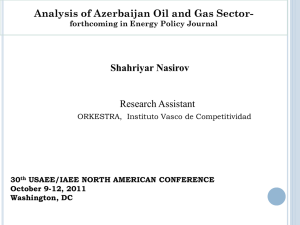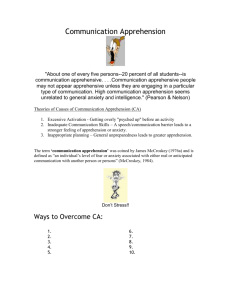Document 10466738
advertisement
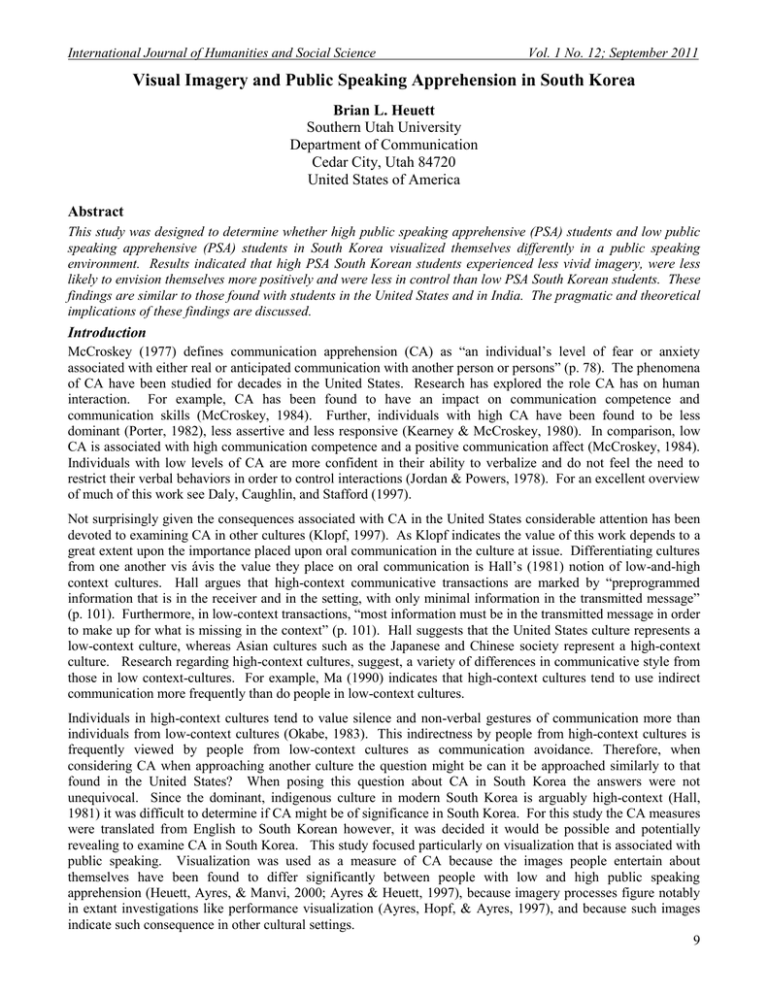
International Journal of Humanities and Social Science Vol. 1 No. 12; September 2011 Visual Imagery and Public Speaking Apprehension in South Korea Brian L. Heuett Southern Utah University Department of Communication Cedar City, Utah 84720 United States of America Abstract This study was designed to determine whether high public speaking apprehensive (PSA) students and low public speaking apprehensive (PSA) students in South Korea visualized themselves differently in a public speaking environment. Results indicated that high PSA South Korean students experienced less vivid imagery, were less likely to envision themselves more positively and were less in control than low PSA South Korean students. These findings are similar to those found with students in the United States and in India. The pragmatic and theoretical implications of these findings are discussed. Introduction McCroskey (1977) defines communication apprehension (CA) as “an individual’s level of fear or anxiety associated with either real or anticipated communication with another person or persons” (p. 78). The phenomena of CA have been studied for decades in the United States. Research has explored the role CA has on human interaction. For example, CA has been found to have an impact on communication competence and communication skills (McCroskey, 1984). Further, individuals with high CA have been found to be less dominant (Porter, 1982), less assertive and less responsive (Kearney & McCroskey, 1980). In comparison, low CA is associated with high communication competence and a positive communication affect (McCroskey, 1984). Individuals with low levels of CA are more confident in their ability to verbalize and do not feel the need to restrict their verbal behaviors in order to control interactions (Jordan & Powers, 1978). For an excellent overview of much of this work see Daly, Caughlin, and Stafford (1997). Not surprisingly given the consequences associated with CA in the United States considerable attention has been devoted to examining CA in other cultures (Klopf, 1997). As Klopf indicates the value of this work depends to a great extent upon the importance placed upon oral communication in the culture at issue. Differentiating cultures from one another vis ávis the value they place on oral communication is Hall’s (1981) notion of low-and-high context cultures. Hall argues that high-context communicative transactions are marked by “preprogrammed information that is in the receiver and in the setting, with only minimal information in the transmitted message” (p. 101). Furthermore, in low-context transactions, “most information must be in the transmitted message in order to make up for what is missing in the context” (p. 101). Hall suggests that the United States culture represents a low-context culture, whereas Asian cultures such as the Japanese and Chinese society represent a high-context culture. Research regarding high-context cultures, suggest, a variety of differences in communicative style from those in low context-cultures. For example, Ma (1990) indicates that high-context cultures tend to use indirect communication more frequently than do people in low-context cultures. Individuals in high-context cultures tend to value silence and non-verbal gestures of communication more than individuals from low-context cultures (Okabe, 1983). This indirectness by people from high-context cultures is frequently viewed by people from low-context cultures as communication avoidance. Therefore, when considering CA when approaching another culture the question might be can it be approached similarly to that found in the United States? When posing this question about CA in South Korea the answers were not unequivocal. Since the dominant, indigenous culture in modern South Korea is arguably high-context (Hall, 1981) it was difficult to determine if CA might be of significance in South Korea. For this study the CA measures were translated from English to South Korean however, it was decided it would be possible and potentially revealing to examine CA in South Korea. This study focused particularly on visualization that is associated with public speaking. Visualization was used as a measure of CA because the images people entertain about themselves have been found to differ significantly between people with low and high public speaking apprehension (Heuett, Ayres, & Manvi, 2000; Ayres & Heuett, 1997), because imagery processes figure notably in extant investigations like performance visualization (Ayres, Hopf, & Ayres, 1997), and because such images indicate such consequence in other cultural settings. 9 © Centre for Promoting Ideas, USA www.ijhssnet.com Furthermore, if the images high and low PSA people entertain differ in significant ways from one culture to another it would indicate evidence of emic qualities of this dimension of CA. However, if such images differ, then etic qualities of CA imagery would be established. Evidence of such would have considerable pragmatic potential. If CA imagery is somewhat universal then interventions designed to target such imagery (e.g., Ayres & Heuett, 2001) may have universal applicability. If not, it may be necessary to develop culturally unique interventions for people in a particular cultural context. The first step in this research study examined whether or not people in South Korea who self-reported experiencing high and low PSA envisioned themselves differently in a public speaking situation. For instance, high PSAs entertain more negative thoughts than do low PSAs (Ayres, 1988; Booth-Butterfiled, 1990; Daly & Lawrence, 1987; Daly, Vangelisti, & Fisher, 1987), it is expected high PSAs in South Korea would envision themselves more negatively than low PSAs. Secondly, high PSAs would naturally generate “dimmer” images or less vivid images than do low PSAs (Wadleigh, 1995). It was expected that high PSAs in South Korea would mirror this phenomena by exhibiting less vivid imagery than South Korean students with low PSAs. The third step entailed imagery in control (Gordon, 1949). People with CA have been found to be particularly concerned with how others evaluate them in public speaking as well as other situations (Leary & Kowalski, 1995), therefore, it was expected that high PSAs in South Korea would depict themselves being “controlled” by the situation more than low PSAs. Method Participants The 300 participants in this study consisted of undergraduate students at a University in South Korea. These students were enrolled in a communication class, which fulfills a communication course requirement. Participants had the option of declining to participate at any time during the study. No incentives were provided to the students, however all students produced the requested information. Data Gathering At the beginning of the semester all participants completed the public speaking sub-scale of the Personal Report of Communication Apprehension (PRCA, Levine & McCroskey, 1990). Student scoring one standard deviation above the mean were considered high PSAs while those scoring one standard deviation below the mean were considered low PSAs. Forty-six high and forty-six low CA students were drawn from these two groups and participated in the study. One class period before delivering an Informative speech students were asked to sketch how they imagined themselves as public speakers. Students were told the quality of their drawings was unimportant and that the main purpose of this exercise was to provide a sketch that represented how they envisioned themselves as a public speaker. After the pictures were collected the students were thanked and debriefed. Instrument The Personal Report of Communication Apprehension (PRCA) was chosen because of the overwhelming evidence regarding its reliability and validity (McCroskey, 1997). The public speaking sub-scale of the PRCA (M = 17.3, SD = 4.21) was used in this study to select participants because we were interested in the dimension of CA. The reliability of the public speaking sub-scale of the PRCA was .90 in this study. Coding Categories Each drawing was coded for valence, vividness, and control. Valence involved the positive, neutral, or negative tone of the drawing. To be considered positive the speaker had to be depicted as smiling and confident (e.g. not shaking, standing erect, etc). Conversely, to be considered negative the speaker in the drawing had to be depicted as frowning and or nervous (e.g., sweating, limbs shaking, etc.). A drawing was considered “neutral” if no positive or negative characteristics were evident. Vividness was operationalized in terms of the amount of detail depicted in the drawing. If the drawing portrayed only one element (e.g., the speaker, the audience, or the environment) it was placed in the “little detail” category. The drawing was placed in the “moderate detail” category if two aspects of the speaking situation were present. The drawing was placed in the “considerable detail” category if the speaker, audience, and environment were all included in the sketch. Control was determined by considering whether the picture depicted the speaker as being “controlled” (e.g., large eyes focusing on the speaker, small in comparison to the audience), or “in control” (e.g., depicted as large relative to the audience, looking directly at the audience, and so forth). 10 International Journal of Humanities and Social Science Vol. 1 No. 12; September 2011 Or “control not detected,” meaning the drawing did not possess control cues. Coder Training Two coders were trained to code drawings for the categories discussed above. Training consisted of explaining the categories and using sketches that were available in a previous study. Coders continued coding the drawings until the .80 level of inter-coder reliability was reached using Scott’s Phi. Once the .80 level of inter-coder reliability was achieved coders independently coded the 92 sketches gathered for the analysis in this study (46 high and 46 low PSAs drawings). Inter-coder reliability in this study ranged from .88 to .94. Naturally coders were blind to the purpose of the study. To control for order effects sketches were numbered from 1 to 92, randomly drawn and presented to the coders accordingly. Since both coders coded all sketches, their scores were averaged prior to the data analysis. Analysis The data were analyzed using chi square. The independent variable was High or Low CA. The dependent variables were the scores on valence (positive, neutral, negative), vividness (little, moderate, considerable), and control (in control, control not detected, not in control). Results The chi-square value for the valence data indicated statistical significance x² (2, N = 92) = 80.00, p < .01. Table 1 reveals that 40 of 46 high PSAs drawings were considered negative, while 40 of 46 low PSAs drawings were considered positive. However, six of 46 drawings were considered neutral for both high and low PSAs. With regards to vividness the chi-square x² (2, N = 92) = 17.72, p < .01indicated significance. Table 2, reveals that 34 of 46 high PSAs drawings provided less vivid images than did low PSAs. Thus, 18 of 46 low PSAs drawings provided “considerable detail” compared to two of 46 of low PSAs. Furthermore, the chi-square with regards of “control” indicates significance, x² (2, N =92) = 70.18, p < .01. As can be seen in Table 3, 34 of 46 high PSAs envisioned themselves as “being controlled” while 36 of 46 low PSAs envisioned themselves as being “incontrol.” Discussion This study investigated to determine whether high PSA students and low PSA students in South Korea visualized themselves differently in a public speaking environment. The drawings that were provided by high and low apprehensive students in South Korea were compared in three categories, valence, vividness, and control. Results indicated that high PSAs envisioned themselves as more negative, less detailed, and as “being controlled” compared to low PSAs depicting themselves as more positive, more detailed, and as “being in-control”. These results are comparable to data reported by Ayres and Heuett (1997) found in the United States, and by Heuett, Ayres, and Manvi (2000) found in India. In both of these studies high PSAs portrayed themselves as more negative, less vivid or detailed, and as “being controlled” compared to that of low PSAs who depicted themselves more positive, more vivid, and being in control in their drawings. Interestingly, the pattern found in South Korea is exactly the same as the patterns found in the United States and India. However, one difference that should be acknowledged here is that the drawings from the South Korean students tend to be much smaller compared to those students from the United States and India. These findings certainly raise an intriguing possibility that people visualize themselves similarly as public speakers across cultures, in general. In three separate studies in three very different cultures data reveals the same significant results with regards to how low and high PSAs envision themselves. Therefore, universal visualization interventions may be productive in helping high PSA speakers cope with their high levels of PSA in the public speaking situation regardless of the speakers culture. However, additional studies need to be conducted in other cultures before this generalization can be considered exclusive. It is stimulating. It is evident that high and low PSAs in South Korea envision themselves differently when depicting themselves as public speakers. The question then arises what difference does it make? It appears that knowledge of this sort may increase how visualization and imagery interventions are used. For example, specific visualization scripts (Ayres & Hopf, 1987, p. 2) could be modified to target the way high PSAs envision themselves as public speakers. Furthermore, possibly implementing Virtual Reality Therapy (North, 1996) that focuses on creating positive images of oneself and motivates the processes of learning in a variety of circumstances, including public speaking, may be considered when helping high PSA people reduce their CA. 11 © Centre for Promoting Ideas, USA www.ijhssnet.com Of course, whether such changes would be useful is unknown. Such changes would have to be examined empirically to validate their worth. This particular study contains several limitations. First, it is not known whether the drawings students provided in this study accurately reflect the images they entertained in their mind. Some of the students may have experienced some level of “drawing apprehension” or possessed inadequate drawing skills. Second, there may not have been an adequate representation of students in this study to provide a concrete perspective of how people truly envision themselves as public speakers. It certainly would be desirable to sample a larger array of people to determine if there are distinguished differences in demographically different groups. Third, there may have been experimental bias whereby participants may not have drawn themselves accurately to avoid being targeted as high or low with regards to public speaking apprehension. Lastly, the directions of the study had to be translated from English to Korean for the students to participate in the study. This may have caused some apprehension in what the students were asked to provide with regards to drawings and filling out the PRCA. However, there is no evidence of such when analyzing and reporting the data. In general, the present study was unique in its attempt to determine whether high and low PSAs in South Korea visualize themselves differently in a public speaking environment. Results indicated that high PSA students envisioned themselves more negatively, less vividly, and being controlled while low PSAs envisioned themselves more positively, more vividly, and as being in control. Interestingly, these findings are very similar to the visualization patterns found with students in India (Heuett, Ayres & Manvi, 2000) and in the United States (Ayres & Heuett, 1997), which indicates the possibility that these findings may exist across cultures. If future studies confirm this possibility and if interventions can be modified to change the way high PSAs visualize themselves, further strides may be made in helping people cope with PSA in public speaking situations and, with time, across a variety of environments. References Ayres, J. (1988). Coping with speech anxiety: The power of positive thinking. Communication Education, 37, 289296. Ayres, J. & Heuett, B. (2001). An examination of the long term effect of Performance Visualization. Communication Research Reports, 17, (3), 229-236. Ayres, J. & Heuett, B. (1997). The relationship between visual imagery and public speaking apprehension. Communication Reports, 10, 87-94. Ayres, J., Hopf, T., & Ayres, D. M. (1997). Visualization and performance visualization: Application, evidence, and speculation. In J. A. Daly, J. C. McCroskey, J. Ayres, T. Hopf, and D. M. Ayres (2 nd Edition.) Avoiding communication, 401-422. Cresskill, NJ: Hampton Press. Ayres, J. & Hopf, T. (1987). Visualization, systematic desensitization, and rational emotive therapy: A comparative evaluation. Communication Education, 36, 236-240. Booth-Butterfield, M. & Booth-Butterfield, S. (1990). The mediating role of cognition in the experience of state anxiety. Southern Communication Journal, 56, 35-48. Daly, J. A., Caughlin, J. P., & Stafford, L. (1997). Correlates and consequences of social communicative anxiety. In J. A. Daly, J. C. McCroskey, J. Ayres, T. Hopf, and D. M. Ayres (2nd Edition.) Avoiding communication, pp. 21-74. Cresskill, NJ: Hampton Press. Daly, J. A., & Lawrence, S. (1987). Self focused cognitions and public speaking anxiety. Paper presented at the annual meeting of the International Communication Association, Honolulu, HI. Daly, J. A., Vangelisti, A. L., & Fisher, W. A. (1987). Pre-performance concerns associated with public speaking anxiety. Paper presented at the annual meeting of the Speech Communication Association, Boston, MA. Gordon, R. (1949). An investigation into some of the factors that favour the information of stereotyped images. British Journal of Psychology, 39, 156-167. Hall, E. T. (1981). Beyond Culture. New York: Doubleday. Heuett, B. L., Ayres, J., & Manvi, M. (2000). Imagery and public speaking apprehension in India. Communication Research Reports, 16, (2), 131-137. Jordan, W. J., & Powers, W. G. (1978). Verbal behavior as a function of apprehension and social context. Human Communication Research, 4, 294-300. 12 International Journal of Humanities and Social Science Vol. 1 No. 12; September 2011 Kearney, P., & McCroskey, J. C. (1980). Relationships among teacher communication style, trait, and sate communication apprehension and teacher effectiveness. In D. Nimmo (Ed.), Communication Yearbook, 4, pp. 533-551. New Brunswick, NJ: Transaction Books. Klopf, D. (1997). Cross-cultural apprehension research: procedural comparisons. In J. A. Daly, J.C. McCroskey, J. Ayres, T. Hopf, D. Ayres (2nd edition.) Avoiding Communication, pp. 270-284. Cresskill, NJ: Hampton Press. Leary, M. R., & Kowalski, R. M. (1995). Social Anxiety. New York: Guilford. Levine, T. R., & McCroskey, J. C. (1990). Measuring trait communication apprehension: A test of rival measurement models of the PRCA-24. Communication Momographs, 57, 62-72. Ma, R. (1990). An exploratory study of discontented responses in American and Chinese relationships. The Southern Communication Journal, 4, 78-96. McCroskey, J. C. (1984). The communication apprehension perspective. In J. A. Daly & J. C. McCroskey (2nd edition.) Avoiding Communication, pp. 13-38. Beverly Hills: Sage. McCroskey, J. C. (1977). Self-report measurement. In J. A. Daly, J.C. McCroskey, J. Ayres, T. Hopf, D. Ayres (2nd edition.) Avoiding Communication, pp. 191-216. Cresskill, NJ: Hampton Press. North, S. M. (1996). Effectiveness of the virtual reality in the motivational processes of learners. International Journal of Virtual Reality, 2, (1), 17-21. Okabe, R. (1983). Cultural assumptions of east and west: Japan and the United States. In W. D. Gudykunst (Ed.), Intercultural communication theory: Current perspectives, pp. 21-44. Beverly Hills, CA: Sage. Porter, D. T. (1982). Communicator style perceptions as a function of communication apprehension. Communication Quarterly, 30, 237-244. Singh, I. (1994). Forging a multi-ethnic union. Journal of Area Studies, 197-198. Wadleigh, P.M. (1995). Imagery and communication apprehension. Unpublished Master’s Thesis. Washington State University, Pullman, WA. Table 1: Valence and Public Speaking Apprehension High Negative 40 Neutral 6 Low 0 6 40 46 12 40 92 Considerable Total 2 46 Total 40 Positive Total 0 46 Table 2: Vividness and Public Speaking Apprehension (Detail) High Little 34 Low 18 10 18 46 52 20 20 92 Total Moderate 10 Table 3: Control and Public Speaking Apprehension High Low Total Being Controlled 34 No Control 12 In-Control 0 Total 46 0 10 36 46 34 22 36 92 13
